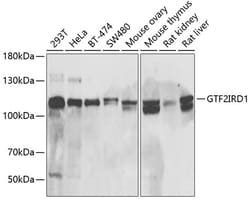Learn More
Invitrogen™ GTF2IRD1 Polyclonal Antibody
Rabbit Polyclonal Antibody
Supplier: Invitrogen™ PA5121015
Description
Positive test controls include: 293T, HeLa, BT-474, SW480, Mouse ovary, Mouse thymus, Rat kidney, Rat liver. The target is usually found in the following locations: Nucleus. Immunogen sequence: SLGFSPPALP PERDSGDPLV DESLKRQGFQ ENYDARLSRI DIANTLREQV QDLFNKKYGE ALGIKYPVQV PYKRIKSNPG SVIIEGLPPG IPFRKPCTFG SQNLERILAV ADKIKFTVTR PFQGLIPKPD EDDANRLGEK VILREQVKEL FNEKYGEALG LNRPVLVPYK LIRDSPDAVE VTGLPDDIPF RNPNTYDIHR LEKILKAREH VRMVIINQLQ PFAEICNDAK VPAKDSSIPK RKRKRVSEGN SVSSSSSSSS SSSSNPDSVA SANQISLVQW PMYMVDYAGL NVQLPGPLNY.
Williams-Beuren syndrome (WBS) is a developmental disorder caused by the hemizygous microdeletion on chromosome 7q11.23. WBS is an autosomal dominant genetic condition that is characterized by physical, cognitive and behavioral traits. The physical traits associated with WBS include facial dysmorphology, vascular stenoses, growth deficiencies, dental anomalies and neurologic and musculoskeletal abnormalities. Mild retardation, a weakness in visual-spatial skills, anxiety and a short attention span are typical cognitive and behavioral traits of WBS patients. The WBSCR11 gene is located within the WBS deletion and may contribute to the developmental symptoms found in WBS because of a loss of the encoded transcription factor. WBSCR11 is also designated GRF2IRD1, GTF3, Cream1 and MusTRD1 in human and BEN in mouse, due to slight differences in gene structure. WBSCR11 is expressed in all adult tissues as several variants and has discrete spatial and temporal expression during embryogenesis.
Specifications
| GTF2IRD1 | |
| Polyclonal | |
| Unconjugated | |
| GTF2IRD1 | |
| 1700012P16Rik; Alb/c-myc line 166.8; Alb-c-myc line 166.8; BEN; Binding factor for early enhancer; c-myc line 166.8; CREAM1; ESTM9; general transcription factor 3; general transcription factor II I repeat domain-containing 1; General transcription factor III; general transcription factor II-I repeat domain-containing protein 1; GTF2I repeat domain containing 1; GTF2I repeat domain-containing 1; GTF2I repeat domain-containing protein 1; Gtf2il; Gtf2ird1; GTF3; hMusTRD1alpha1; Muscle TFII-I repeat domain-containing protein 1; muscle TFII-I repeat domain-containing protein 1 alpha 1; MUSTRD1; MusTRD1/BEN; RBAP2; slow-muscle-fiber enhancer-binding protein; Tg(Alb1-Myc)166.8Sst; transcription factor GTF3 alpha 2; transcription factor GTF3 gamma 2; USE B1-binding protein; WBS; WBSCR11; WBSCR12; Williams-Beuren syndrome chromosomal region 11 protein; Williams-Beuren syndrome chromosomal region 12 protein; Williams-Beuren syndrome chromosome region 11; X83320 | |
| Rabbit | |
| Affinity Chromatography | |
| RUO | |
| 246770, 57080, 9569 | |
| -20°C, Avoid Freeze/Thaw Cycles | |
| Liquid |
| ELISA, Western Blot | |
| 0.12 mg/mL | |
| PBS with 50% glycerol and 0.02% sodium azide; pH 7.3 | |
| Q9JI57, Q9UHL9 | |
| GTF2IRD1 | |
| Recombinant fusion protein containing a sequence corresponding to amino acids 660-959 of human GTF2IRD1 (NP_057412.1). | |
| 100 μL | |
| Primary | |
| Human, Mouse, Rat | |
| Antibody | |
| IgG |
Your input is important to us. Please complete this form to provide feedback related to the content on this product.
